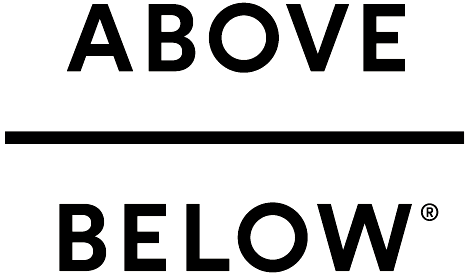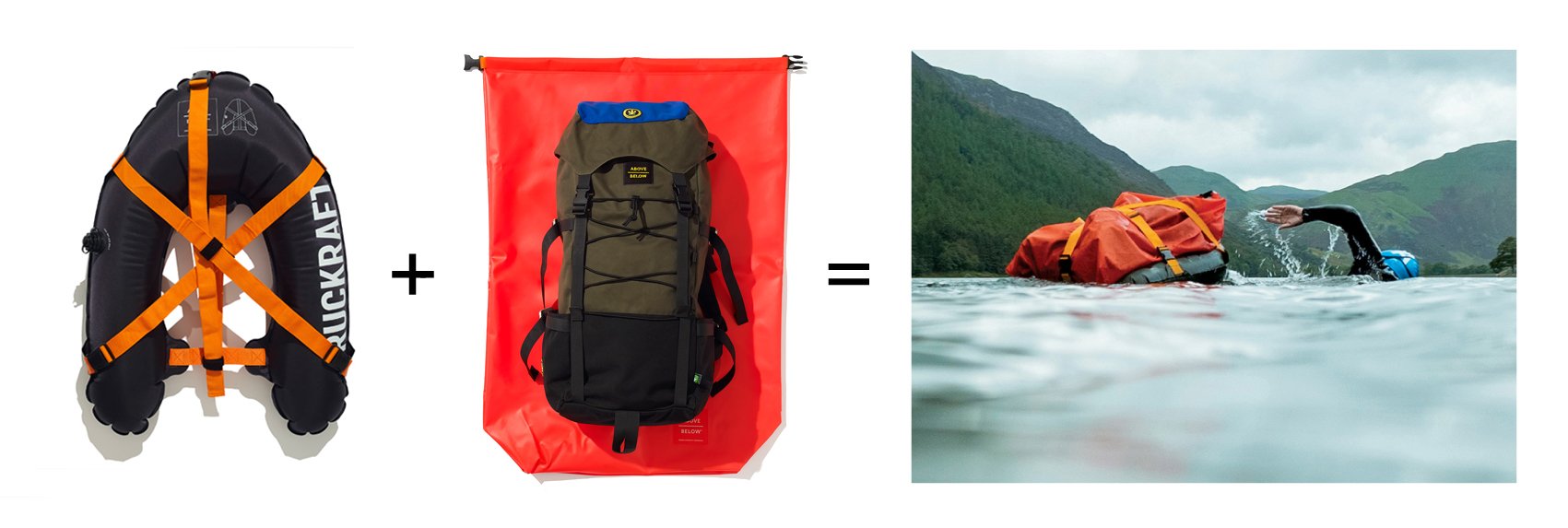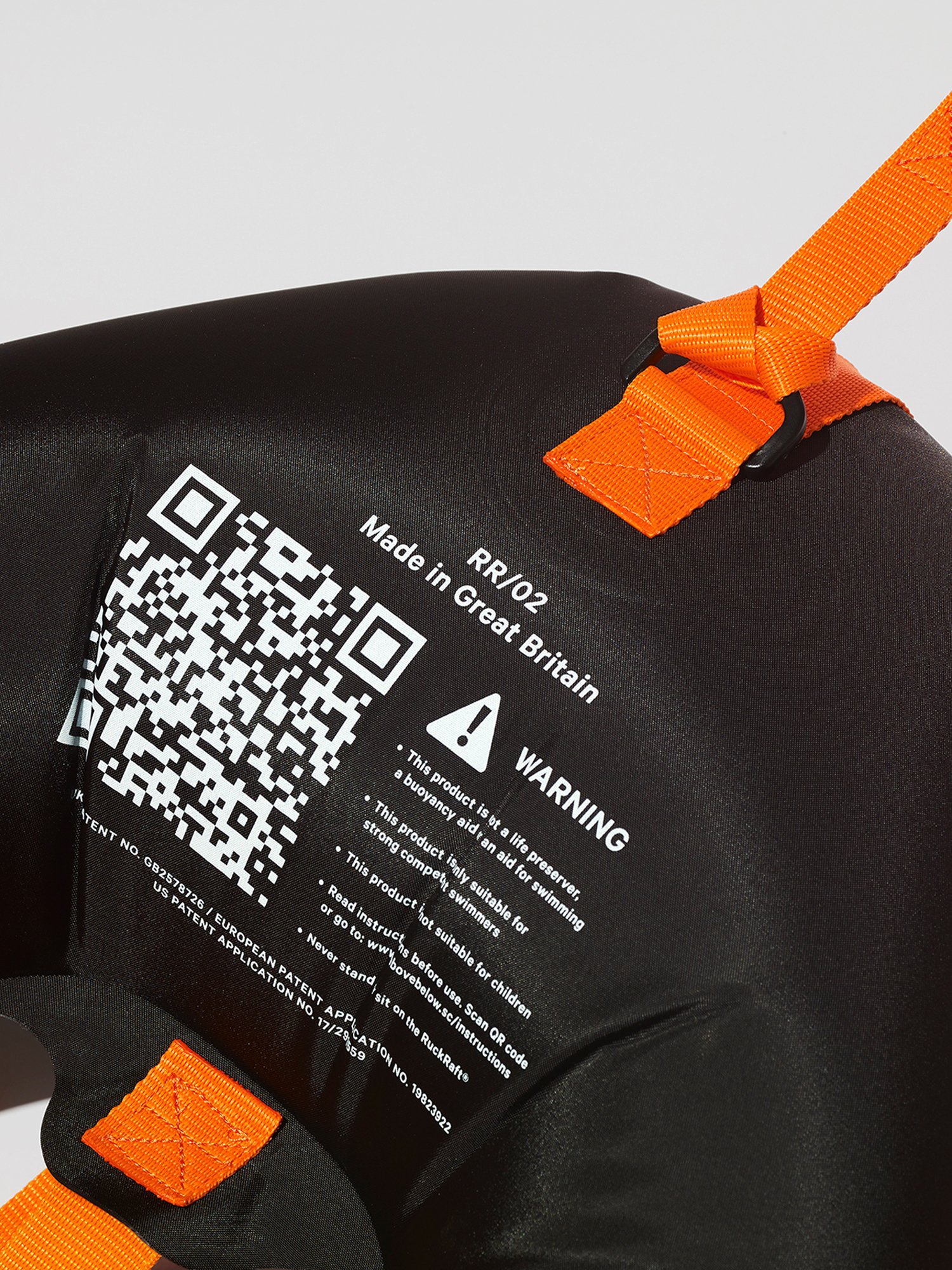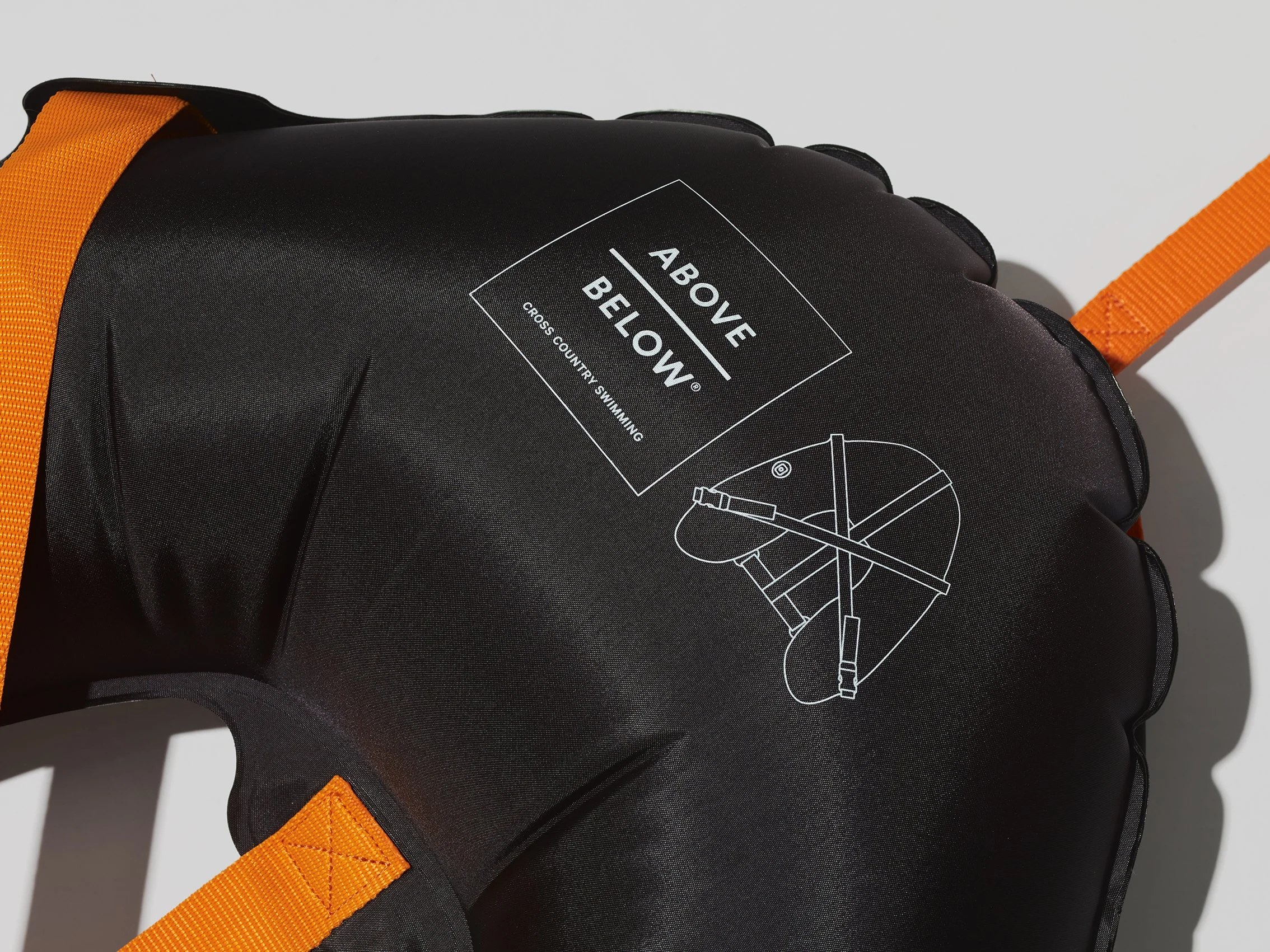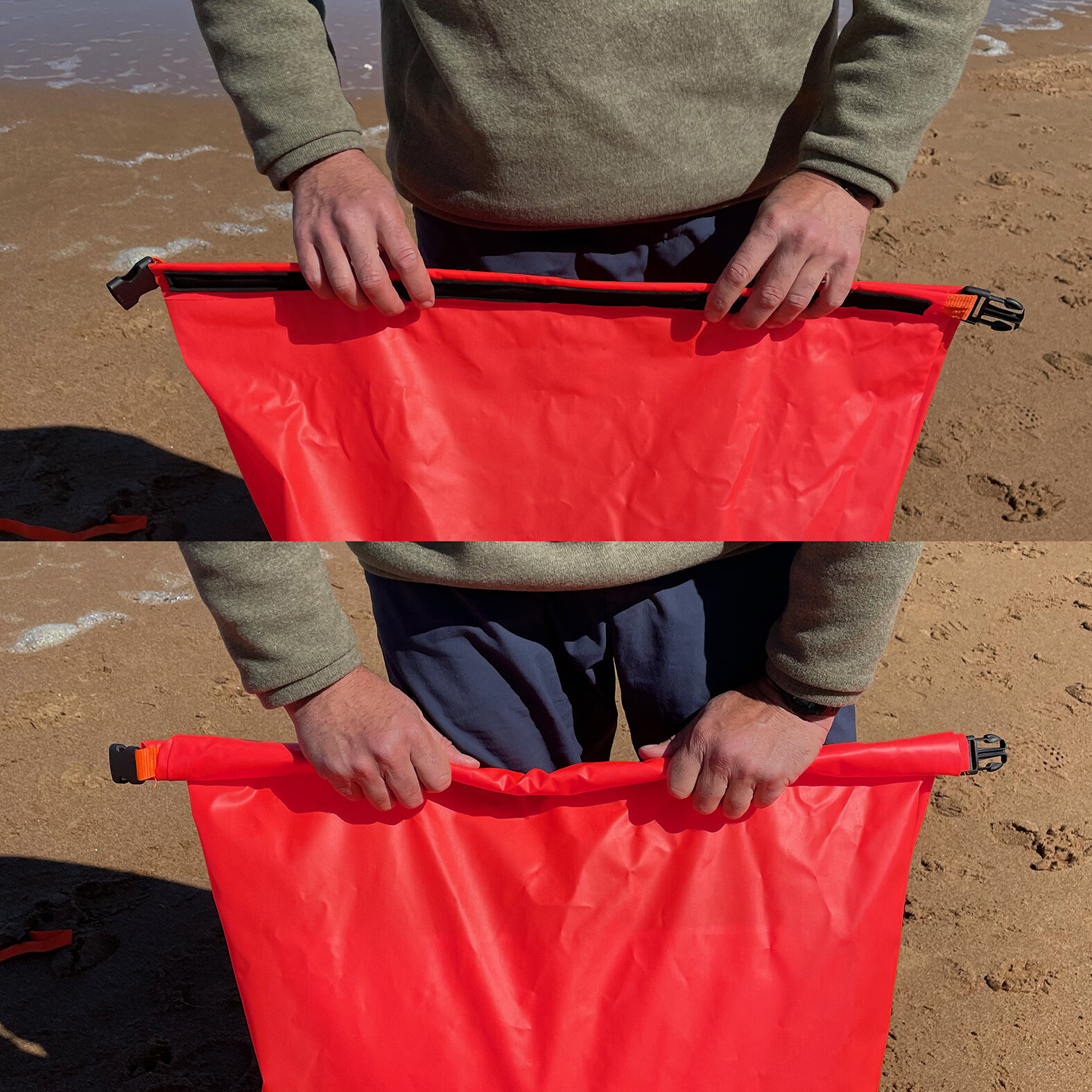Introducing the RuckRaft®.
A simple, two-piece kit to open up new adventures over land and water.

THE NEXT GENERATION TOW FLOAT FOR OUTDOOR SWIMMERS.
MADE IN GREAT BRITAIN SINCE 2018 AND PATENTED WORLDWIDE (PATENTED. UK - GB2578726 / USA - US11219289 / Europe - EP3876782)
RuckRaft meets the required Safety Testing of ISO 25649 1&7 2017 for floating leisure products.
The RuckRaft® is a fully inflatable raft that comes with a giant drybag into which you can pour everything: your favourite rucksack, drying robes, walking boots, picnic, tent and as many layers of clothes as you need for a big day out or weekend of adventure over land and water.
The unique, streamline design and superior buoyancy means the RuckRaft® glides across the water even when fully loaded with over 15kg of gear. Equally at home on a lake, river or sea, the RuckRaft® is a multiplier for any swim adventure.
Shortlisted for the The Great Outdoors Gear of the Year Awards 2020, Innovation Award (recognising new breakthroughs in outdoor gear that make a real difference).
Patented worldwide, the RuckRaft® RuckRaft meets the required Safety Testing of ISO 25649 1&7 2017 for floating leisure products.
We also offer RuckRaft® rental through our friends at Tri Wetsuit Hire, so you can try before you buy. Find out more:
CUSTOMER REVIEWS

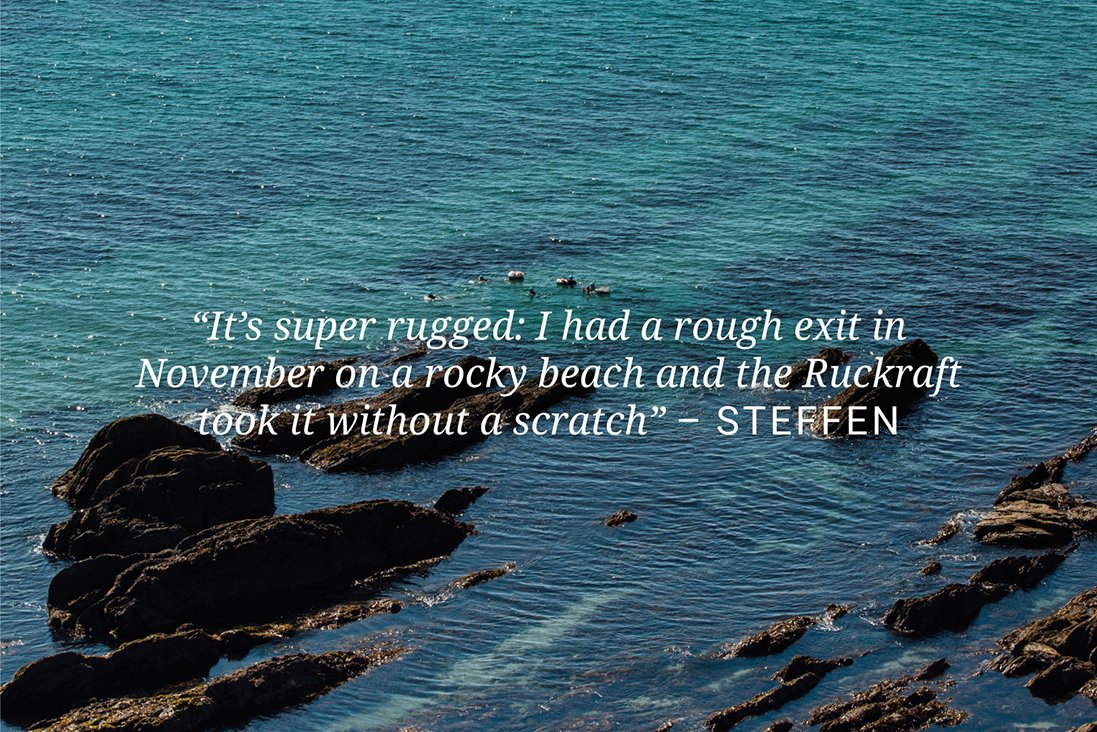

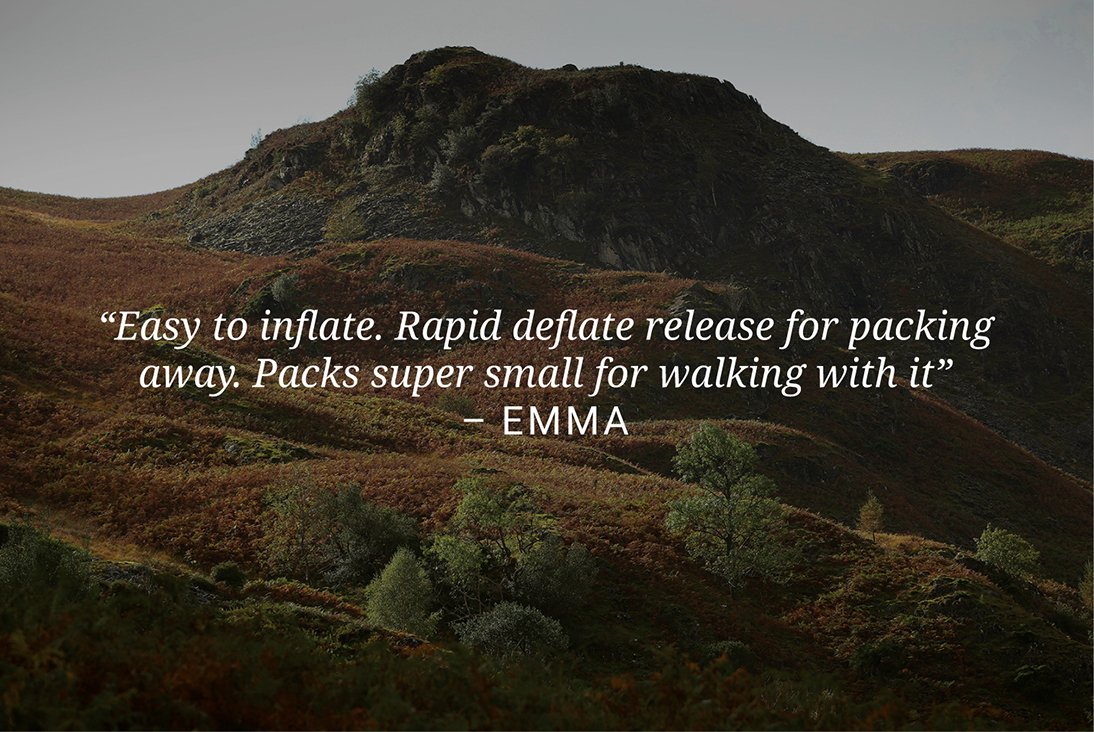

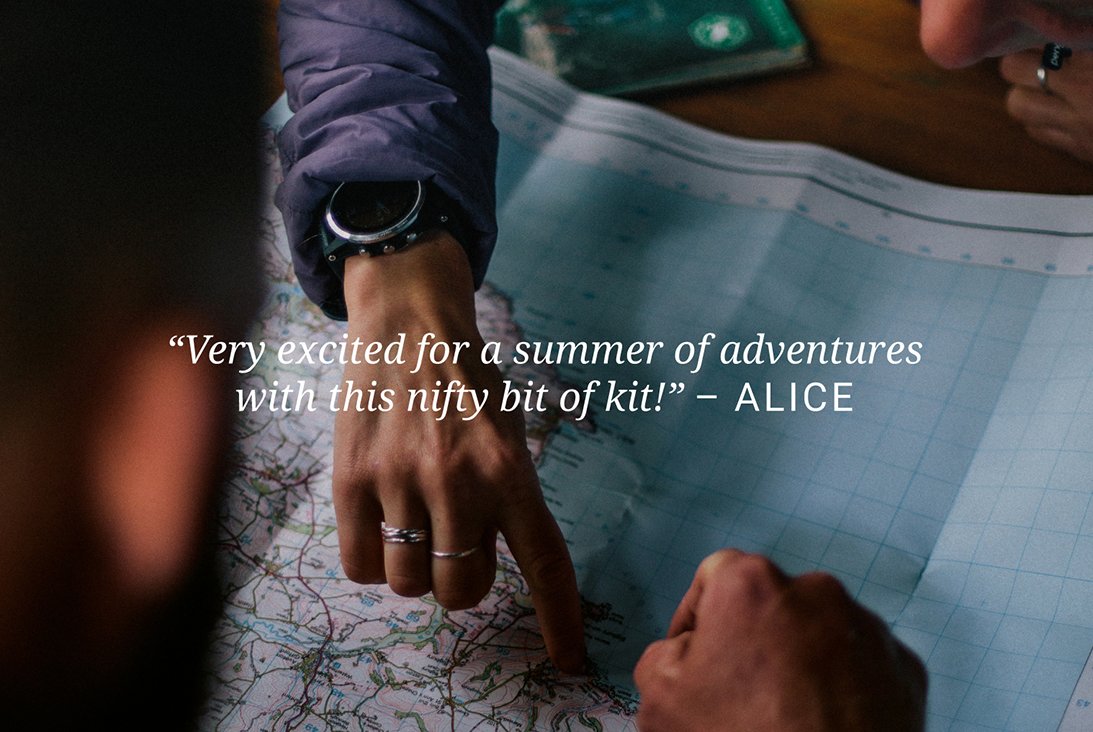
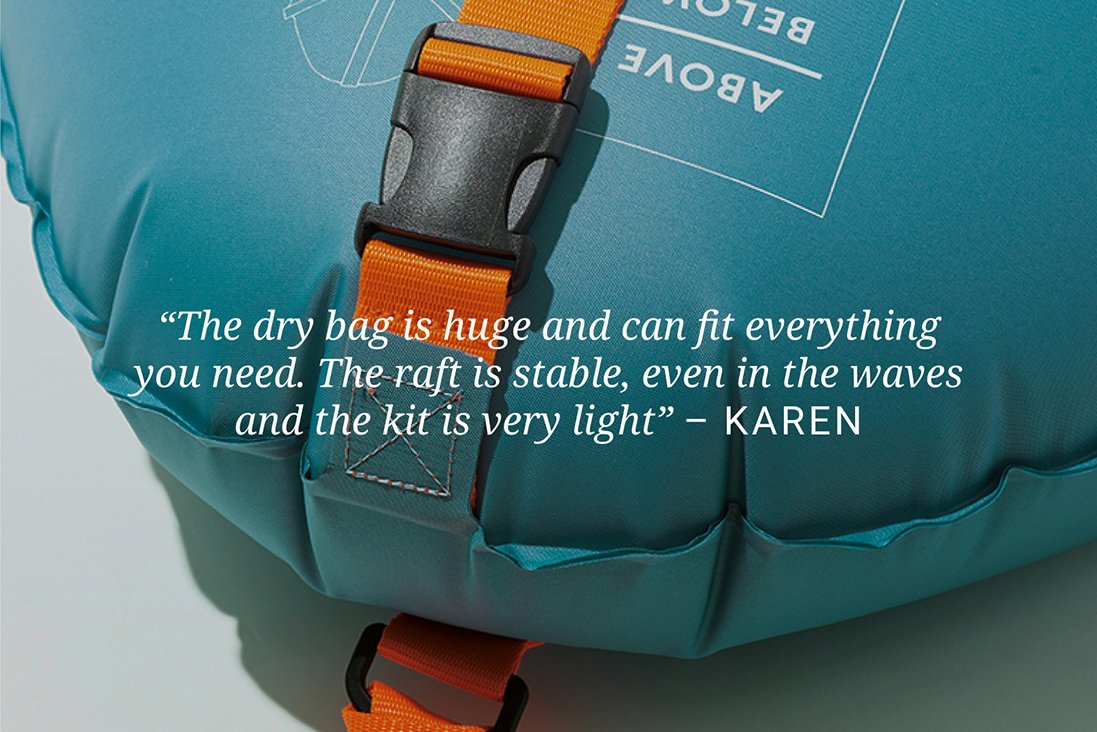
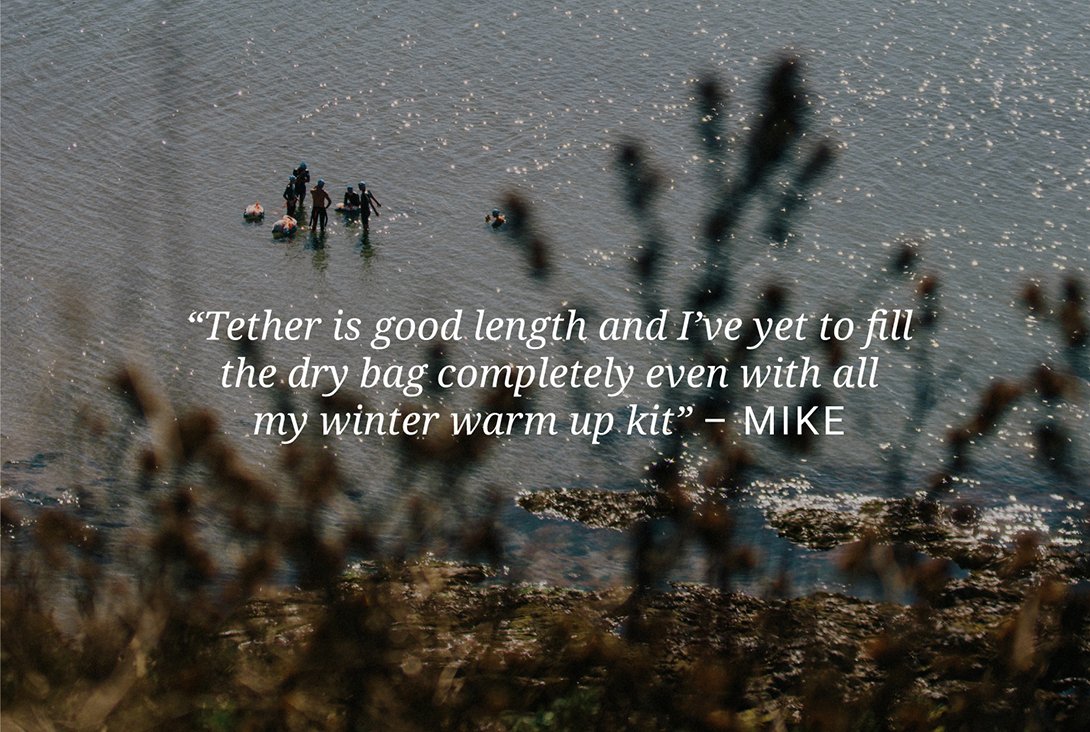
AS SEEN IN
“We’ve never seen anything as smart and as purpose built as the RuckRaft ... Everything about this product screams well made quality. Beautifully designed, functional piece of kit that opens up a new world of cross country swimming”– Kate Rew, Outdoor Swimming Society
And on BBC Breakfast and in The Sunday Times
RUCKRAFT FEATURES
Why is RuckRaft® the next generation tow float?
1.
SUPERIOR BUOYANCY and stability
The U shape, rib boat design provides extra stability, with the load sitting between the arms of the raft. It will comfortably support a full 70L, 15kg Expedition pack yet remain streamline and easy to tow.
RUCKRAFT IS STABLE ON THE SEA IN BIG SWELLS.
RuckRaft meets the required Safety Testing of ISO 25649 1&7 2017 for floating leisure products.
2.
TOUGH, MARINE-GRADE, RIVERTEX® MATERIALS.
Made in great britain.
3.
XL DRYBAG INCLUDED - TO WORK WITH ANY RUCKSACK
WE LOVE HIKING AND A TRUSTED, COMFORTABLE RUCKSACK IS essentiaL. SO we designed the ruckraft TO
work with your EXISTING, FAVOURITE PACK.
WATERPROOF SWIM RUCKSACKS LACK THE GOOD BACK AND LUMBAR SUPPORT IMPORTANT FOR HIKING.
WITH THE RUCKRAFT, YOU GET THE BEST OF BOTH WORLDs – NO COMPROMISE ON RUCKSACK QUALITY, CAPACITY OR BuoYANCY.
And all your kit stays 100% dry.
4.
TWO-WAY VALVE, easy to inflate
5.
PACKABLE & LIGHTWEIGHT AT ONLY 1KG
6.
Superior hardware
Strong straps, robust YKK clips and high-frequency welded seams make it tough and built for adventure.
RuckRaft meets the required Safety Testing of ISO 25649 1&7 2017 for floating leisure products.
7.
Definitely no zips!
Zips are the first thing to DEGRADE AND GO WRONG - ESPECIALLY around SEA WATER, grit, dirt and sand.
so we don’t use any.
8.
Bright Orange DRYBAG for extra visibility and safety in the water
USING THE RUCKRAFT
Below are some points of guidance on using and maintenance of your RuckRaft.
Inflating and getting in the water:
Inflate the Raft on a surface unlikely to have anything that can puncture it. In shallow water if possible.
Inflation and valve:
Check the valve thread is free from sand, grit etc. A little rinse in water does the trick.
The valve is two way - after inflation only finger tighten the valve or it can become stiff. After a swim and packing away - undo both valves and a bit of grease to keep the valve lubricated is a good idea.
Packing the drybag:
Place everything inside the drybag. Then roll down onto the neoprene at least 3 times, leaving air in the bag if possible. That way, even in the unlikely scenario of the Raft deflating, the dry bag will still float.
Loading the raft:
Put the full drybag onto the Raft. Balance slightly over the front nose where the RuckRaft is most buoyant. The RuckRaft should float flat on the water or slightly tilting up at the front like a rib boat.
Secure your gear with the vertical strap first – this is the big strap that runs from the bottom to the nose of the Raft. This locks the drybag in position.
Securing the Dry-bag – Vertical strap:
Feed the vertical strap through the dry bag handle loop. This gives you the strongest hold and tow point for the RuckRaft in and out of the water. It also helps to strap down and secure the drybag seal.
Securing the Dry-bag – ‘X’ Straps:
After the vertical strap, use the two diagonal straps to secure your dry-bag into position. To tighten the straps it is easier to adjust the webbing when the clips are undone, and then clip together when you have the optimum length.
Lifting the loaded raft:
The best way to lift, pull or hold the whole RuckRaft both in and out of the water is by the drybag loop.
Alternatively, hold and lift all three straps together at the point where they all cross on top of the fully loaded RuckRaft.
Attaching the leash:
Simply attach the leash to the D-ring on the front nose using a ‘Lark's head knot’ by feeding the looped end through the D-ring, then taking the rest of the leash through the loop. Attach the self tightening leash around your waist (some use ankles or their shoulder).
-
— The RuckRaft can float up to 15kg but start with less and build up as you become more confident and experienced with the kit.
— Packing up - fold raft vertically one wing over the other, lay onto middle of dry bag, fold sides of bag over the raft, roll up like a sleeping bag from bottom up to open top.
-
— The RuckRaft is made of tough, marine grade, durable Rivertex materials with high frequency welded seams. The Drybag has no zips to go wrong. However, cross country swimming can be rough and tumble and takes place across all sorts of terrain. This means we can’t give you any guarantees unfortunately. But here are a few basics in terms of how to look after your kit.
— Do not leave the RuckRaft in the sun any longer than necessary.
— Rinse, hose down the raft in freshwater after a swim (especially if in the Lake District as there is a risk of transferring invasive species).
— Dry the RuckRaft and bag dry out of direct sunlight before rolling up and packing away until your next adventure.
-
— Given the RuckRaft is inflatable, there is a risk of puncture (although with the Rivertex material this should be very rare). Two fixes are available: Gorilla tape - quick and dirty. The Gorilla Tape ‘handy roll’ is described as ‘Perfect for: traveling, camping, boating, sporting and more!’. And they can add RuckRafting to the list, this a good portable solution that stays adhered in water. (£3 from most hardware stores)
— For longer term repairs we will soon have a kit of patches that adhere and bind in water. In the meantime, Stormsure Watersports Repair Kit does a great long term job with their tuff tape or glue.
— If the puncture is more of a rip and tear then drop us a line to hello@abovebelow.sc. There are a few solutions with the Bostik 3206 Glue but those are more likely to require a fix by us or the factory.
-
Above Below are Tom and Will Watt - but our dad Jim and other brother Dan are both experts in environment and manufacturing. Dad has recently built an off grid, zero carbon house and for his whole life worked in energy saving and waste minimalisation for business and governments around the world.
So the below is from our Dad, Jim, who has probably forgotten more than most of us know about the area of energy saving, climate change, waste minimalisation.
Making an inflatable:
To make the RuckRaft we needed a manufacturing process for an inflatable vessel – in many ways the RuckRaft is a mini Rib boat. Many inflatables use PVC plastic which is not at all environmentally friendly and increasingly controversial. But some form of man-made rubber or plastic is pretty unavoidable.
It is not as simple as plastic is the problem:
As Green Peace and many other groups spell out, single use plastic is a problem particularly for marine life. But this is often complicated and compensated for by plastics role in reducing food waste and in reducing the need to use animal products (leather, wool).
Scale and context is important – you have to recycle 100’s of polythene bags to equate to the energy used by just one litre of petrol or diesel. So while recycled plastic may sound good if the travel involved getting the plastic from waste to recycling is significant it might be counter productive. And very few of the claims you hear will be factoring this in.
Then, where would we be without durable water proofing and breathability for outdoor clothing and construction. A much bigger problem all round is buying too much short life kit and stuff and the consumption of animal based products (and food).
Plastic is indispensable for so much of what is a broadly meant by the phrase sustainable (e.g. climate change and using up less of nature’s resources). It’s just not as simple as plastic = bad.
The manufacturing process for the RuckRaft:
For an inflatable vessel there often has to be some sort of welding to bind the two side of the inflatable together. And this requires either heat, hot air or high frequency welding. We use the high frequency welding as it is the strongest and most suitable to ensure the RuckRaft is as durable as possible.
RuckRaft uses Rivertex TPU coated Nylon:
The high frequency welding process requires special fabric. We work with Rivertex ‘Riverseal’. Designed specifically for high-performance marine applications.
The fabric is durable Nylon fabric, strengthened with a full TPU (thermoplastic polyurethane) coating on one side and reinforced with a TPU lick coating on the other side, giving it exceptional air-holding capabilities. Nylon for high performance, weldable, air holding applications. TPU is fully recyclable and biodegradable. Nylon is not an easy or cheap material to recycle but it is possible.
This means that the RuckRaft® is a little more expensive but also built to last. The next step is to work on the sustainability and find method for recycling the Nylon.
The future is likely to be recycled fabric:
Rivertex in 2021 has launched Rivercyclon® brand which are 100% recyclable. See www.rivercyclon.com These are aimed at replacing PVC coated products for more industrial applications like tarpaulins and print banner PVC.
As Rivercyclon® is 100% Polypropylene it is recyclable and can be ground down to make other harder rigid polypropylene products e.g. travel coffee mugs. But Rivercyclon is heat or hot air weldable - so may not last as well.
Nylon is possible to recycle and fabrics like Econyl are promising. But again it will be down to how these recycled materials, which are often not as strong, respond to the high frequency welding process that makes the RuckRaft so tough. We are exploring our options with the above.
We do know about and think about these things. On a bigger picture - the RuckRaft is about enabling adventures closer to home. If the RuckRaft inspires someone to holiday and explore their own country for some swim/hike adventures rather than fly away for a city break, we’ll have actually done much more for the environment.
It’s not simple. The trade offs and counter productive measures are everywhere in this area. But we’ll be doing our best.
Further reading:
If you are further interested in this area and want to truly get under the hood of what matters, we used to be on the board of Manchester based workers co-operative Ethical Consumer. These folks really are great. They follow the money.
Follow the RuckRaft® journey from idea to reality.
